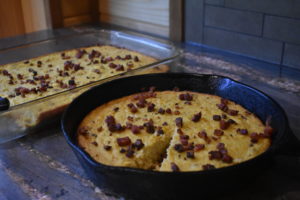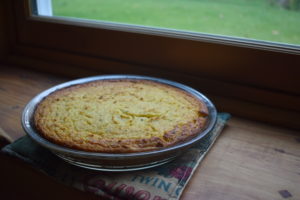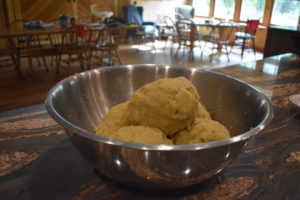By Laura Killingbeck
Published Nov. 2018
There’s nothing like the smell and flavor of real corn, baked into cornbread or roasted on a skillet as a tortilla. Corn has been grown and eaten in these ways for thousands of years throughout the Americas. Unfortunately, in many areas, genetically modified, chemical-dependent corn monocultures have given this plant a dicey reputation. But older corn varieties, grown organically on small farms and cooked using  traditional methods, are a beautiful expression of corn’s real and wonderful legacy in the human diet.
traditional methods, are a beautiful expression of corn’s real and wonderful legacy in the human diet.
Many small farms are able to integrate some type of field corn into their planting rotations. This corn must be grown to maturity, dried, husked, and shucked before the corn is ready to enter the kitchen as a sack of dry corn kernels.
Once the corn is in this form, it requires further processing. At this point your two options are to grind it into flour, or nixtamalize it into a dough often referred to by its Spanish name, masa. Nixtamalization is a process of cooking the corn in an alkaline substance, usually hardwood ash or lime. This removes the pericarp (seed husk) of the kernel, which is unpalatable. Mature corn pericarps also inhibit the absorption of niacin in the human body. When people eat large quantities of mature corn without nixtamalization, they can suffer from serious nutrient deficiencies. Nixtamalization also changes corn’s consistency in a way that is essential for certain recipes like tortillas. For these reasons, we generally nixtamalize whole corn before using it as food.
Below is the wood ash nixtamalization recipe and cornbread recipe we use at Round the Bend Farm in Massachusetts. For a nixtamalization recipe using lime, as well as a traditional tortilla recipe, please see this article in the Tico Times.
Nixtamalized Corn with Wood Ash
Any wood ash used in this recipe should be hardwood, with no residues from toxic materials or construction waste. Different types of woods burn into different qualities of ash. You can research the ideal wood type growing in your area, or try what you have from your wood stove.
At Round the Bend Farm, we use a variety of hardwoods sustainably harvested from the property. We burn this wood during the winter in a wood stove, and the ash falls below the stove into a tray. When the tray is full, we remove it and pour the ash through a fine sifter into a five gallon bucket. We store this for use in nixtamalization. The alkalinity of your wood ash will vary depending on the type of wood that made the ash. This is a conservative recipe that calls for a lot of wood ash—you very well may be able to try a few batches and find that you can use less ash.
This recipe makes 15 cups of whole corn. You can reduce or increase the ingredients within their ratio as necessary.
Ingredients:
15 cups whole, dry field corn
15 cups hardwood ash, sifted
Water
Instructions:
DAY 1
- Rinse the corn thoroughly in water. Remove any particles, floating pieces, dirt, or corn silk.
- Cover with at least four inches of water and let soak 12-24 hours in a covered pot.
DAY 2
- Drain the corn, rinse again, and add nine liters of water. Mix in hardwood ash.
- Put the corn and ash water on the stove and bring to a boil.
- After the corn reaches a rolling boil, reduce the heat to a strong simmer and cook 30-60 minutes, until the corn is tender and skins are separating and dissolving away from the kernels. The corn should be easy to bite into, but still have a bright white point in the center. The kernels should be firm and intact with the germ and tip still present.
- Take the corn off the heat and let it rest for at least one hour.*
- Drain the corn into a sturdy metal colander and rinse well with water. You need to make sure all the ash is rinsed off of the corn—otherwise the final product will taste sharp and chalky. Rub the kernels between your hands and/or against the holes in the colander to remove all the clear kernel skins. Again, use plenty of water. Once the corn is thoroughly rinsed and cleaned, it is called nixtamal. When you grind nixtamal, it forms a dough which is often referred to as masa.
*We have tried many variations of this resting time, including letting it sit overnight, or not resting at all. Letting the corn rest in the alkaline solution after boiling is thought to further transform the starches and give the tortilla a better structure. Do what works best for you.
Uses:
Nixtamal can be used whole in soups, casseroles, salsas, and side dishes; it can be ground for tortillas, corn crusts, or made into cornbread, polenta, tamales, or atole. When stored in consistent, good quality refrigeration, whole or ground nixtamal keeps for up to a week.
Grinding Nixtamal into Masa—Tools and Scale
The simplest way to grind nixtamal into masa is with a Corona Hand Mill. This is a basic, widely available plate mill that crushes the corn into a fine paste. This works well on a small scale. It can work fine on a larger scale if you are willing (and able to) invest the time and labor into hand grinding.
At Round the Bend Farm, we occasionally use an electric Fabio Leonardi Tomato Miller to grind nixtamal into masa. This machine was originally designed to process tomatoes into sauce, but it also works to pulp and separate other soft-cooked fruits, vegetables, legumes, etc. For medium and large batches, this machine is much more time-efficient than using the hand mill. However, it does take more effort to put together, clean, and break down than the hand mill, so for small batches (say a gallon or less of corn) the hand mill would still be my first choice.
I have not yet read of anyone else using the Fabio for nixtamal. One very, very important factor in the use of the Fabio for grinding nixtamal is that the corn MUST be cooked softer than you would normally cook it if it were to be ground in the Corona Hand Mill. Each kernel must be soft, with no white spot in the center. If it is too firm it will clog the machine, which is very difficult and time-consuming to unclog. I have not personally noticed any disadvantages to “overcooking” the corn for use with the Fabio. Within the tradition and literature of corn nixtamalization, it’s often noted that proper cook time—specifically not under OR overcooking—is essential to the formation of proper dough elasticity for tortilla masa. However, this has not been a problem for us so far using this method., and we still get fragrant flexible tortillas.
There are other electric wet mills on the market, but I have not used these so I cannot comment on them here. The scale of your grinding tool is a primary consideration for realistic utilization of nixtamal.
Update 2021: The Fabio remains one of my all-time favorite multi-purpose kitchen tools, however, we did eventually have an issue with it. The cylindrical metal sieve where the food is pushed through broke apart one day when we were processing carrots. The carrots were cooked but were still slightly firm. So it really is imperative that this tool is used only for soft foods. I still recommend the Fabio as a multi-purpose tool that can occasionally handle batches of soft-cooked nixtamalized corn, but if folks are looking for a tool specifically for regular nixtamalization, I’d stick with the Corona hand mill or an electric wet mill that is intentionally designed for corn.
Nixtamalization and Efficiency
So, you’ve probably noticed by now that nixtamalizing and grinding corn is a bit of work. However, when you consider the full spectrum of post-harvest processing for other grains like wheat, rye, etc, corn is really probably one of the easier grains to process on a home or community scale.
Whether you are nixtamalizing corn at home or for a restaurant or larger organization, it is essential to manage efficiency of the process. Otherwise, it will simply be too labor intensive (expensive, difficult, and/or frustrating) to include in your basic pantry. The ways to manage efficiency of nixtamalization are:
- Investing in the right scale of grinding equipment to fit your needs—hand or electric, large or small.
- Cooking and grinding the corn in large batches. You can batch up to the size that will be eaten within a week if you are refrigerating the nixtamal, and much longer if you are freezing or drying it. My own experience is with weekly refrigeration. If you do this whole process just for a single meal, you will probably give up on corn! But if you do the process once and use it for many meals, it’s worth it.
- Making nixtamal and masa consistently (say, once a week every week, or once a month every month) in order to build skill and rhythm with the process, as well as to most effectively incorporate corn into reliable dishes that you enjoy and look forward to.
- Honing your corn variety for storage, flavor, and ease of nixtamalization. Corn varieties respond to nixtamalization in very different ways—some take a short time to shed their pericarps and soften, others take hours. These differences are also affected by how the corn was stored. You ideally want to grow or source corn that responds well to nixtamalization, and keep growing and sourcing this same variety in the long term. I have found that buying dry corn from different farmers yields extremely different cooking scenarios, masa consistency, and flavor. You want to hone this to make it better and more predictable.
- Considering easier post-nixtamalization corn recipes. Bless the hearts of Latin American women everywhere who have long made individual tortillas and tamales from nixtamalized corn! These are amazing foods and worth making. They also take a lot of skill and practice, and are time consuming to produce post-nixtamalization. There are other traditional recipes like cornbread (or in Latin America, variations of tamal asada or pozole) that are easier to make, especially when you are starting out with nixtamalization. They are also delicious.
As always, if you live in an area with an ongoing tradition of nixtamalization and utilization of corn, go visit the folks who are doing it and check out their process! This is the best way to keep local food traditions and local plant varieties alive and thriving.
Honey Gold Cornbread Recipe
This is a recipe I developed at Round the Bend Farm, and it is our base recipe for cornbread made with nixtamalized corn. It’s easy to make and responds well to added ingredients and variations (see bottom of  recipe). It is a thick, cakey cornbread.
recipe). It is a thick, cakey cornbread.
Makes one 9-inch pie pan.
Ingredients:
3 cups masa (fresh ground nixtamalized corn)
2 eggs
2 tsp baking powder
1 tsp sea salt
¼ cup honey
½ to 1 cup milk (quantity is variable based on moisture content of masa—start with ½ cup and increase from there)
¼ cup butter or lard, melted
Instructions:
- Preheat oven to 425 F
- Mix ingredients together until fully combined. Batter should be thick but pourable.
- Grease a 9-inch pie pan and pour in the batter.
- Bake until firm in the center. Moisture content affects baking time—check after 20 minutes, but you may need to bake for longer.
- Cool before cutting. Serve plain, or with melted cheese or jam.
Optional Variations (tested and approved!):
–Add ¼ tsp ground nutmeg
–Add ½ tsp dried sage
–Add 1 cup caramelized onions
–Add 2/3 cup finely chopped, cooked bacon; use the bacon fat from cooking as your lard in the recipe
–Replace 1 cup of masa with 1 cup of acorn flour




